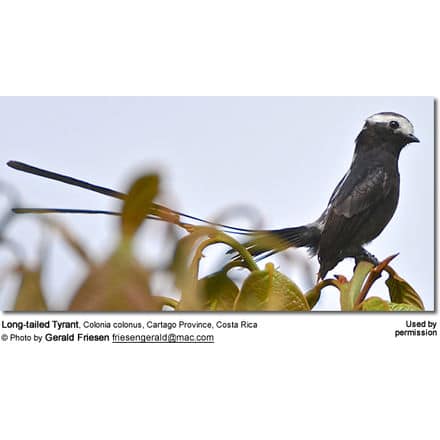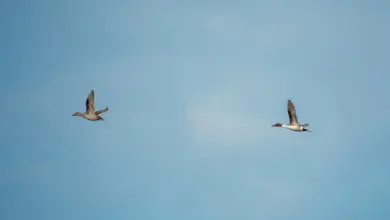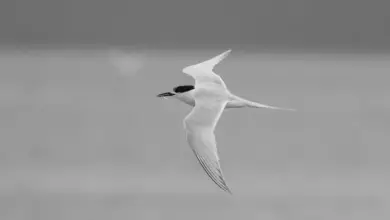Long-tailed Tyrants
Long-tailed Tyrants
Overview … Alternate (Global) Names … Distribution / Habitat … Subspecies, Ranges and ID
Description … Calls / Vocalizations … Breeding / Nesting … Diet / Feeding
The Long-tailed Tyrants (Colonia colonus) – also known as White-backed Flycatchers – are distinctive flycatchers found in Latin America, from Honduras in Central America south to Argentina in South America.
Distribution / Habitat
Their range stretches from southeastern Honduras south through Nicaragua, Costa Rica, Panama to Colombia, Venezuela, Guyana, Suriname and French Guiana; and from southeastern Ecuador south through Peru, Bolivia, to southeastern Brazil, Paraguay and northeastern Argentina. These birds appear to be lacking from most of the central Amazon Basin.
They inhabit subtropical or tropical moist lowland and moist montane evergreen forests, as well as heavily degraded former forest. They are most commonly seen at the edges of forests, near or on dead trees or exposed branches from which they catch flying insects.
The Long-tailed Tyrants are mostly resident; except for southern populations that migrate during the austral winters.
Subspecies and Ranges:
- Long-tailed Tyrant (Colonia colonus colonus – Vieillot, 1818) – Nominate Form
- Range: Central and eastern Brazil, from Marajó Island and southern Maranhão in northern Brazil south to southern Mato Grosso do Sul and northern Rio Grande do Sul), east Paraguay and northeastern Argentina (Misiones).
- Long-tailed Tyrant (poecilonota) (Colonia colonus poecilonota – Cabanis, 1848)
- Range: Southeastern Venezuela south of the Orinoco River and in the Amazonas, and the Guianas.
- Long-tailed Tyrant (leuconota) (Colonia colonus leuconota) (Lafresnaye, 1842)
- Range: Southeastern Honduras and eastern Nicaragua south to western Colombia and western Ecuador.
- Long-tailed Tyrant (fuscicapillus) (Colonia colonus fuscicapillus – P. L. Sclater, 1862)
- Range: East Andes of Colombia, northern Ecuador and extreme northeastern Peru, where they occur in the mouth of the Curaray River.
- Long-tailed Tyrant (niveiceps) (Colonia colonus niveiceps – J. T. Zimmer, 1930)
- Range: Southeastern Ecuador, Peru (San Martín south to northern Puno), and northern Bolivia (south to Cochabamba).
Description
Size
Long-tailed Tyrants measure 9.1 – 11 inches (23 – 28 cm) in length, with a pair of elongated central tail feathers that extend up to 5 inches or 12 cm beyond the rest of the tail.
Plumage Details / Adults
The plumage is dull black, except for the conspicuous white crown, forehead and the white patch on the rump.
Diet / Feeding
They mostly feed on flying insects, such as stingless bees. Insects are caught during quick flights, and the Long-tailed Tyrants will often return to the same perch.
Breeding / Nesting
They build their nests in tree cavities 26 – 98 feet (8 – 30 meters) above ground. The average clutch consists of 2 – 3 eggs. The female will roost in the nest box for weeks before egg laying. The pair will aggressively defend their nests against intruders.
Calls / Vocalizations / Sounds
Alternate (Global) Names
Chinese: ???? … Czech: Tyranovec dlouhoocasý … Danish: Spatelhaletyran
Dutch: Langstaarttiran … Finnish: Nauhapyrstötyranni … French: Moucherolle à longs brins, Moucherolle à raquettes … German: Langschwanztyrann, Langschwanz-Tyrann, Weißkappen-Schleppentyrann … Estonian: händtikat … Guarani: Jetapa hû, Jivere hû, Jivere hü … Italian: Tiranno codalunga … Japanese: shiragafutaotairanchou … Norwegian: Pendeltyrann … Polish: bialoglowik, bia?og?owik … Portuguese: freirinha-da-serra, maria-viuvinha, viúva, Viuvinha, viuvinha-tesoura … Russian: ????????????? ?????? … Slovak: pamuchár steblochvostý …. Spanish: Atrapamoscas Rabijunco, Mosquero Colilargo, Mosquero coludo, Mosquitero Colilargo, Tirano colilargo, Yetapá Negro … Swedish: Långstjärtstyrann
Species Research by Sibylle Johnson
Please Note: The articles or images on this page are the sole property of the authors or photographers. Please contact them directly with respect to any copyright or licensing questions. Thank you.
The Avianweb strives to maintain accurate and up-to-date information; however, mistakes do happen. If you would like to correct or update any of the information, please send us an e-mail. THANK YOU!





